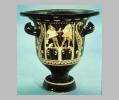
Side A: two comic actors
[Image not available]
Three-dimensional approximation of the vase
| Collection: | London, British Museum |
| Summary: | Side A: Two comic actors in costumes and masks on an elevated stage |
| Ware: | Paestan Red Figure |
| Painter: | Attributed to Python |
| Context: | From Capua |
| Date: | ca. 340 BC |
| Dimensions: | H. 0.40 m.; Diam. (max.) 0.39 m |
| Primary Citation: | |
| Shape: | Bell krater |
| Region: | Campania |
| Period: | Late Classical/Early Hellenistic |
Decoration Description:
Side A: Scene from a comedy. A high stage is supported by a Doric column and two pilasters, from which hang two purple fillets and four vine branches. On it a father drags his son home from a banquet. The father is on the right; he has a mask with short, stiff, white hair, a beard and moustache. He wears a jerkin and leggings, over which is a short white chiton with yellow stripes and a purple border, and an embroidered mantle is wrapped round his body and over his left arm. He wears a purple phallus and has a padded stomach, which is the standard equipment of comic actors. In his left hand he carries a hooked stick, and he walks to the right, looking back, while grabbing his son's wrist with his right hand. The son wears a mask with black hair and beard, and a wreath. He carries a lantern in his right hand, and a phiale (drinking vessel) and purple fillet with yellow spots in his left. He wears clothes similar to his father's. Behind him is a swan, pecking on the ground.
Side B: Two youths stand facing each other. The one on the left has long curly hair, in which is a wreath. He wears a long chiton and himation with a dotted border, sandals, and carries a staff. The other wears a fillet, and his clothing is similar to the first. In his right hand he holds a fillet and a white fruit or ball, in his left is a staff. Between them a fillet hangs on the wall.
The himatia borders are typical of Python's style (Trendall, 203, fig. 17).
The upper border is a laurel wreath, the lower is a wave pattern. Palmettes are below the handles.
Collection History:
Castellani Collection, 1873.
Sources Used:
Other Bibliography: